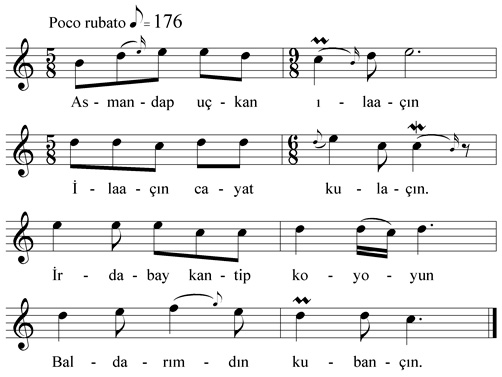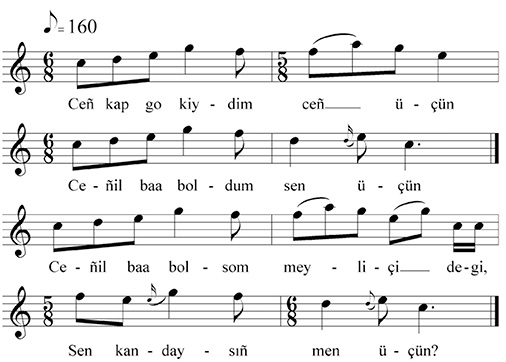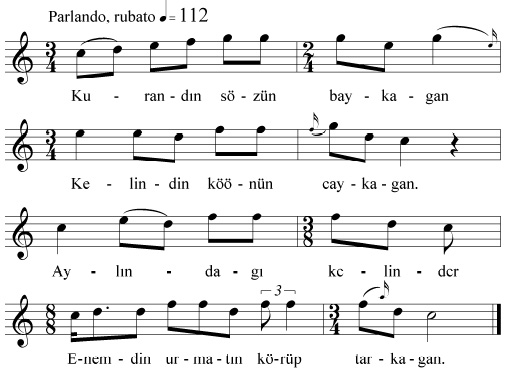- 1. Twin-bar tunes (ex.1-11, №1-58)
- Twin-bar tunes based on the g,-c bichord
- Twin-bar tunes based on rotating motifs
- Twin-bar tunes with descending/hill-shaped lines
- Motifs with a downward leap at the end of the line
- Motivic processes
- 2. Tunes moving on Ionian scales (ex.12-24, №59-164))
- Laments and their relatives
- Two-lined tunes of Major character with higher main cadences and their four-lined relatives
- Four-lined tunes of Major character
- 3. Aeolian tunes (ex.25-36, №165-238)
- Laments and related tunes
- Aeolian tunes with higher main cadence
- Four-lined tunes of Minor character
- Valley-shaped, ascending or undulating first line
- 4. Caramazan religious tunes (ex.37-41, №239-326)
- 5. Tunes of domed structure (ex.42-43, №327-332)
2.2. Two-lined tunes of Major character with higher main cadences and their four-lined relatives (№114-132)
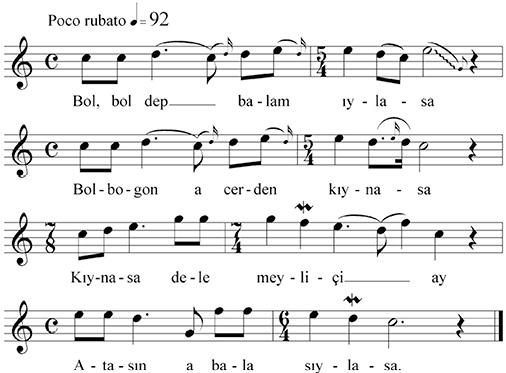


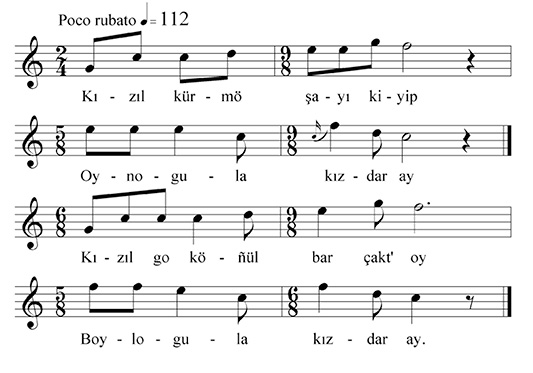

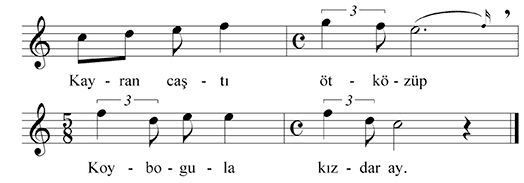


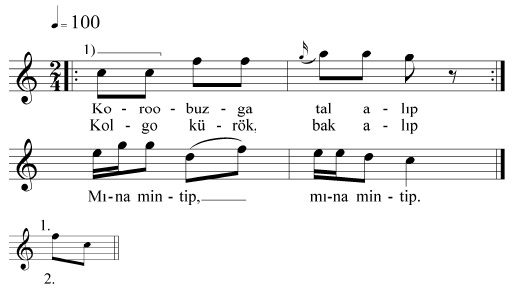


In the group of tunes of Major character with two short lines and (5) main cadence, some different melody outlines can be found.
2.2.1. (5) main cadence, first line undulating on E-D-C trichord (ex.17a-b, №114-115). The starting line of tunes in the first subgroup undulates on the E-D-C trichord (ex.17a). I put here some seemingly four-lined tunes of AB|CB form with 5(b3)x cadences, whose first part tallies with the two-lined tunes with (5) main cadence, and whose second part resembles the first melody section in broad outlines although the third line does not end on the 5th or b3rd degree (ex.17b).
a)

2.2.2. (5) main cadence, first line tracing a bulge with G’/A’ peak (ex.18, №116-121). The second subgroup has tunes with (5) main cadence, whose first line draw a hill with a G’/A’ peak, but within this hill-shape some Minor undulation can also quite often be found. The whole tune of №117 well demonstrates the rising-falling contour so typical of many Kyrgyz tunes.
Unlike in the music of most Turkic groups, the Kyrgyz tunes not infrequently use the 6th degree for a cadence, and even the main cadence. The 6th degree sometimes “substitutes” for the 5th, but at other times it is independent.
2.2.3-4. (6) main cadence, two-lined forms and some others derivable from two-lined forms (ex.19a-b, №122-127). The exact two-lined form is rare among these tunes (first 2x2 lines of ex.19a); predominant forms are ABBvB, ABAvBv even AB|CB… that can be retraced to two-lined forms. (ex.19b) Most start with an ascent but a high hill or a line reciting the 7th-8th degree can also be found. Ex.19a also exemplifies the relationship between tunes with (5) and (6) main cadences.
a)



2.2.5-6. (7) and (8) main cadence, two lined forms and their derivatives (ex.20a-b, №128-132). Far more are the tunes with (7) main cadence, divided into two subgroups. Earlier we saw tunes whose first line stepped from the 5th to the 7th degree at the end. These were ranged with tunes with (5) main cadence. The first line of these tunes in this group trace a distinct rise up to the 7th degree (ex.20a). I ranged here high-starting four-lined tunes that can be traced to two-lined forms, e.g. ex.20b of ABBB form with 7(b3)b3 cadences.
a)

Among two-lined tunes of a Major character or those traceable to two lines no first line ending higher than the 7th degree can be found.
1 ex.17a, Song for chidren, Matayeva Ayımkan (1932, Ak-Talaa), Sarıbağış-Töböy, Aça-Kayıñdı, 2002; ex.17b, Mother’s song, Asılbek kızı Alımkan (1936, Bakıyan), Keldey, Ogombayev (Beştaş), 2004
2 ex.18, , Satı kızı Bopuy (1923, Boğoştu), Çerik-Kara-Boston, Baş-Kayıñdı, 2002
3 ex.19a, Folksong, Kıdırova Tursun (1921, Ceñiş), Buğu-Çıçkan, Ceñiş-wedding, 2002; ex.19b, Shepherd’s song (Çabandın armanı), Süyörkul İsmankulov (1937, Kara-Kol), Cetigen, Köpüröbazar, 2004
4 ex.20a, Children’s song, Mamır Kıdırmayev (1933), Moğoldor, Birlik, 2004; ex.20b, Lament (Koşok), Abdrahmanova Kakış (1928, Barskoon), Buğu-Bapa, Darhan, 2002

